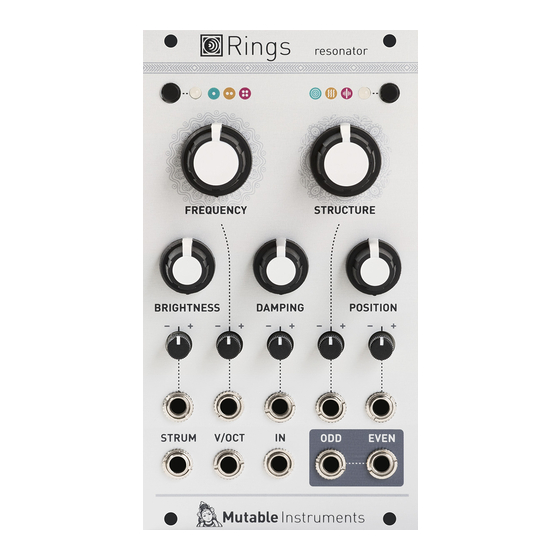
Advertisement
Quick Links
A
B
C
D
E
F
G
H
1
2
3
4
5
6
Front panel
Controls
A.
Polyphony setting. Selects between monophonic,
duophonic or quadriphonic operation.
B.
Resonator type. Modal, sympathetic strings or
non-linear/inharmonic string.
C.
Coarse frequency. Quantized in semitones when a
cable is patched in the V/OCT
(3)
input.
D. Harmonic structure. Frequency ratio between the
partials of the modal resonator, detuning of the sym-
pathetic strings, or non-linearity/inharmonicity of the
string.
E. Brightness. Adjusts the level of higher harmonics in
the signal, by the simultaneous action of a low-pass fil-
ter on the exciter signal (closed at 8 o'clock, fully open at
12 o'clock), and of the damping filter (or Q factor of the
higher modes) on the rest of the course of the potenti-
ometer.
F. Damping. Controls the decay time of the sound.
G. Excitation position. Controls on which point of the
string/surface the excitation is applied. This setting will
remind you of the PWM control of a square oscillator –
or of the comb-filtering effect of a phaser.
H. Attenuverters for the CV inputs.
Inputs and outputs
1. Resonator parameters CV inputs. Note that the
FREQUENCY CV input is normalized to a small constant
voltage, allowing its attenuverter to be used as a fine
frequency control when no patch cable is inserted.
2.
Strumming trigger input, for polyphonic operation.
Whenever a trigger is received on this input, the module
freezes the currently playing voice, lets it decay, and
starts a note on the next voice. This input is normalized
to a step detector on the V/OCT input and a transient
detector on the IN input.
3.
V/Octave CV input. Controls the main frequency of the
resonator.
4.
Audio input for the excitation signal. Modular levels
are expected! This input is normalized to a pulse/burst
generator that reacts to note changes on the V/OCT CV
input or triggers on the STRUM input.
5, 6.
Odd and even audio outputs. In monophonic mode,
these two outputs carry two complementary compo-
nents of the sound (odd and even numbered partials
with the modal resonator, dephased components due to
picking position and pickup placement with the string
resonators).
In polyphonic mode, they split the signal into odd and
even numbered strings/plates.
Note that you need to plug a cable in the EVEN
(6)
output
to actually split the two signals – otherwise they will be
mixed together and sent to ODD (5).
Rings
Resonator
Advertisement

Summary of Contents for Mutable Instruments Rings
-
Page 1: Front Panel
Rings nents of the sound (odd and even numbered partials F. Damping. Controls the decay time of the sound. with the modal resonator, dephased components due to picking position and pickup placement with the string G. - Page 2 Installation Rings’ polyphony can be set to one, two, or four notes. If no patch cable is inserted in the IN audio input, the filter. The Q factor of the filter determines how sustained the oscillations of the corresponding partial are.

Need help?
Do you have a question about the Rings and is the answer not in the manual?
Questions and answers